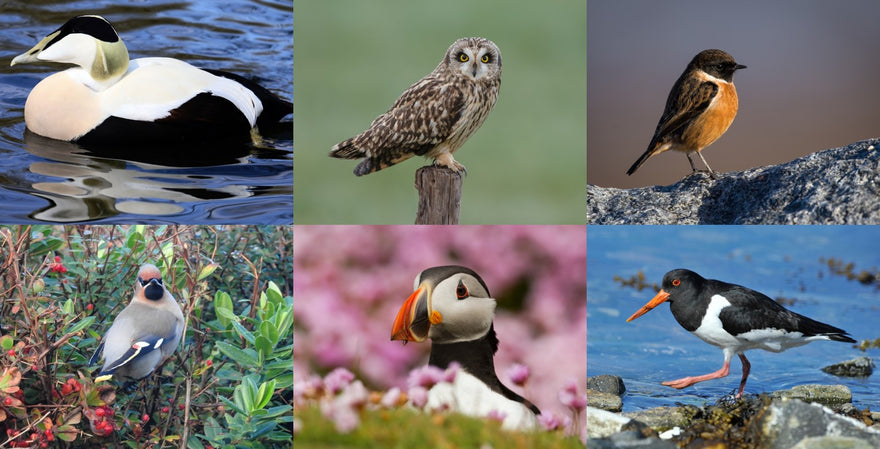July 26, 2017

Of course, Orkney is famed for its wondrous wealth of wildlife given its location, rich and varied habitats, remote areas and dramatic coastlines. Indeed, Orkney is home to many national and international nature sites, and the RSPB manage 13 reserves covering around 8,500 hectares of land. Thousands of birds visit or reside in Orkney, the largest colonies of Guillemots and Kittiwakes in the UK can be found here - each with over 60,000–70,000 pairs. Orkney also ranks as one of the most important places in Europe to see the spectacular sky dancing Hen Harrier.
Our Natural Orkney Collection features species such as: Puffin, Oystercatcher, Stonechat, Eider, Short-eared Owl and Waxwing. Many types of birds in Orkney have local names, often derived from Old Norse, or related to the birds appearance or habitat. Here’s a welcoming introduction to our feathered friends:

Puffin
Orkney Name: Tammie-Norrie
These beautiful charismatic sea birds arrive in Orkney waters in March and prepare for their summer residency which lasts until early August. Puffins prefer nesting in grassy banks, but can also be seen nesting in holes and crevices along cliff faces. Orkney’s largest colony can be found on remote Sule Skerry where there are around 60,000 occupied burrows, however, if you’re lucky you can also spot them at the Brough of Birsay, Deerness and South Ronaldsay.

Oystercatcher
Orkney Names: Skeldro, Chaldroo, Shaalder
Striking black and white, with long red legs and bill, Oystercatchers are a very familiar sight around Orkney. They tend to nest in a variety of habitats from shingle beaches, loch shores, hill fields and even road verges. When in flight, they have an obvious white wing strip, black tail and white rump that extends as a ‘V’ between the wings. They’ll often attract your attention with their loud peeping call and can be seen in Orkney from early spring to mid-winter.

Stonechat
Stonechats can be seen in Orkney for most of the year. Inquisitive, bold and eager to attract attention with their highly audible call, similar to two stones being tapped together. Males have striking black heads, with white around the side of the neck, orange-red breasts and a mottled brown back. Female colouring is more subdued and lacks the black head and white collar. They are generally easy to see, frequently on high perches, bushes, gorse and hopping along fence posts. Being an insectivore, harsh winters can be very challenging for Stonechats, but luckily Orkney’s recent succession of mild winters has seen increased numbers in the county.

Eider Drake
Orkney Name: Dunter
Eiders are a familiar site around most of Orkney’s coastline and sheltered stretches of water. It’s the UK’s heaviest yet fastest flying duck. The drake has very distinctive plumage, with a black cap, emerald nape, white chest, black wings and yellow bill. In early spring, many can be seen in Scapa Flow and around the lochs and shores in early summer. Females build a scape nest on the ground, usually near water, which is lined with vegetation along with their own down feathers. They lay a clutch of around 2-7 eggs, which are incubated for 22 – 23 days. The young are then collectively raised by the females.

Short-eared Owl
Orkney Name: Cattie-face
Catching a glimpse of a honey coloured Short-eared Owl always lifts the spirits. Its tail and wings are boldly barred; its body plumage is brown, spotted and streaked with buff, yellow and white. Its bronze facial disc sets off the most beautiful amber eyes. Owls can be seen during the daylight, throughout Orkney for most of the year, but become a bit harder to locate during winter and long winter nights when they become more nocturnal. The Short-eared Owl nests in May, often in heather and rushes and raise between 2-3 chicks per year. They also hunt the famous Orkney vole, unique to Orkney for over 4,000 years.
Waxwing
Waxwings brighten dark winter days in Orkney. They appear during the winter months, sometimes on a fairly large scale, but can still be difficult to find. They descend on sheltered garden areas and feed on red berries, rose hips, fuchsia pods and fruit trees. These stunning birds have an exotic silky plumage, distinctive head crests, black mask, yellow-tipped tails with black, white and red wing markings. Waxwings were given their name due to the bright red tips on their wings, which look like drops of red sealing wax used to seal envelopes. As a Waxwing gets older, the size of its coloured wax tips increases.
See our Natural Orkney Collection throughout our website.
July 17, 2018
April 23, 2018
Sign up to get the latest on sales, new releases and more …
